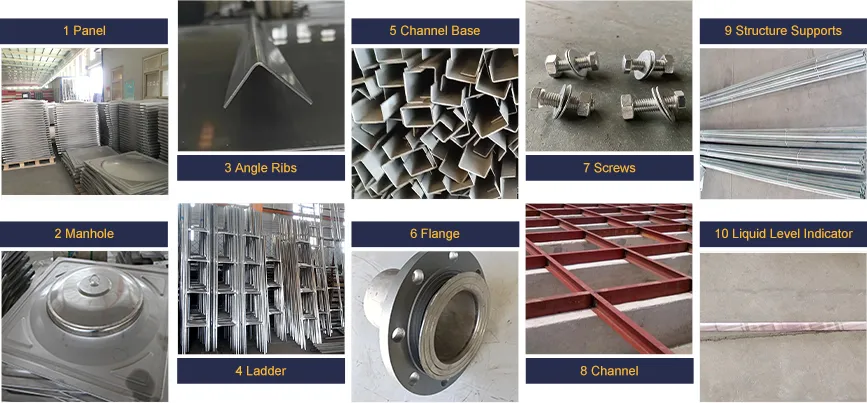loading...
- No. 9, Xingyuan South Street, Dongwaihuan Road, Zaoqiang County, Hengshui, Hebei, China
- admin@zjcomposites.com
- +86 15097380338
- Welcome to visit our website!
Sectional Water Storage Solutions for Modern Infrastructure and Efficient Water Management Systems
Understanding Sectional Water Tanks Benefits and Considerations
In today’s rapidly advancing world, the demand for efficient water storage solutions has never been higher. Sectional water tanks have emerged as a popular choice for a diverse range of applications, from residential to industrial uses. This article aims to delve into the intricacies of sectional water tanks, exploring their benefits, considerations, and applications.
What are Sectional Water Tanks?
Sectional water tanks are modular storage solutions typically made from materials like fiberglass, steel, or reinforced concrete. Unlike traditional water tanks, which are often pre-fabricated and delivered as a single unit, sectional tanks consist of multiple panels or sections that can be assembled on-site. This modular design offers flexibility in installation and transport, making sectional tanks particularly appealing for locations with space constraints or difficult access.
Benefits of Sectional Water Tanks
1. Flexibility and Customization One of the primary advantages of sectional water tanks is their flexibility in design and capacity. These tanks can be customized to meet specific requirements, whether for domestic water supply, fire fighting systems, or industrial processes. The ability to fit the tank dimensions to the available space makes them ideal for urban environments.
2. Modular Construction The modular nature of sectional tanks allows for easy expansion or modification. Should water storage needs increase, additional sections can be added without the need for replacing the entire unit. This is particularly beneficial for growing businesses or communities.
3. Ease of Installation Sectional water tanks can be installed quickly and easily, often without the need for specialized equipment. This feature reduces overall labor costs and downtime, providing a significant advantage for projects with tight timelines.
4. Durability and Longevity Made from high-quality materials, sectional water tanks are designed to withstand various environmental factors, including extreme temperatures, corrosion, and UV exposure. When properly installed and maintained, they can have a long service life, making them a reliable investment.
5. Cost-Effectiveness The modular design often results in lower transportation costs and installation expenses compared to traditional tanks. Additionally, the ability to expand the tank as needed means that users are not overspending on unnecessary capacity upfront.
sectional water tanks

Considerations When Choosing Sectional Water Tanks
While sectional water tanks present numerous advantages, there are several considerations to keep in mind when deciding whether they are the right fit for your needs.
1. Maintenance Requirements Like all water storage solutions, sectional tanks require regular maintenance to ensure optimal performance and hygiene. Depending on the material chosen, some tanks may require more frequent inspections and repairs.
2. Local Regulation Compliance It’s crucial to check local regulations regarding water storage tanks. Different regions may have specific codes and standards that need to be adhered to, which can affect the design and installation of sectional tanks.
3. Initial Costs While sectional tanks can be cost-effective, the initial setup expenses can vary significantly based on size, material, and the complexity of installation. Prior budgeting and planning are essential to avoid unexpected expenditures.
4. Space Considerations Although sectional tanks are designed to fit specific spaces, it is essential to carefully evaluate available installation areas. Factors such as accessibility for maintenance, proximity to water supply lines, and local infrastructure can impact the overall effectiveness of the tank.
Applications of Sectional Water Tanks
Sectional water tanks are versatile and find applications across various sectors. They are commonly used in residential areas for domestic water supply, in industrial settings for process water, and in agricultural sectors for irrigation purposes. Additionally, they are frequently employed in municipal infrastructure for emergency water reserves and firefighting needs.
Conclusion
Sectional water tanks offer a flexible, durable, and cost-effective solution for diverse water storage needs. As urbanization and industrial growth continue to accelerate, the demand for effective water management solutions will likely increase. By understanding the benefits and considerations associated with sectional water tanks, stakeholders can make informed decisions that enhance their water storage strategies, ultimately promoting sustainability and efficiency in their operations. Whether for home, business, or public use, sectional water tanks represent a modern approach to an age-old necessity the storage of water.
-
Transform Your Spaces with FRP Grating SolutionsNewsNov.04,2024
-
The Versatility and Strength of FRP RodsNewsNov.04,2024
-
The Excellence of Fiberglass Water TanksNewsNov.04,2024
-
The Benefits of FRP Grating for Your ProjectsNewsNov.04,2024
-
Elevate Your Efficiency with FRP Pressure VesselsNewsNov.04,2024
-
Welcome to the World of FRP Pressure VesselsNewsOct.12,2024
-
Unveiling the Future of Filtration: Why FRP Filter Vessels are a Game ChangerNewsOct.12,2024
